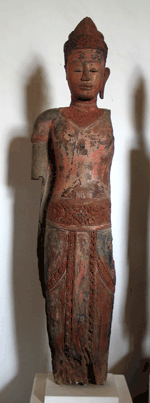COLLECTION
WOODEN OBJECTS
———————————————
ADORNED BUDDHA
 Material:
Polychrome wood Material:
Polychrome wood
Dimensions: H: 134 cm
Date: XVth - XVIth century
Provenance: Angkor Conservation, Siem Reap
Collection: National Museum of Cambodia,
Phnom Penh
Gha.44
There are two different techniques for carving Buddhist statues
from wood, with the first technique, the artist would take a segment
of a tree trunk and carve directly into it incorporating the ears,
hands, arms and other ornaments. This method is comparable to those
of the ancient Khmers who used to carve a block of stone to create
a sculpture. The most impressive example in the Xth century is a
large block of stone used to carve two monkeys (Sugriva and Valin)
on a common pedestal. These figures are animated in movement yet
opposed in symmetrical positions. The second technique involved
the attachment of additional sections - usually hands, ears, feet
and other ornaments. This method was used for the adorned Buddha
with lacquer ornaments. In order to attach the parts, the artist
encased a wooden core (mortised and glued) and attached the lacquer
ornaments. To protect these works of art against insects and water
and conceal the fissures, various layers of natural and coloured
lacquers and paints extracted from different trees were applied:
black for the first layer, red for the second and finally gold.
The conception of the Buddha as a king is encountered
in many Khmer writing.
In general, high quality wood is used for Buddha
sculptures including ‘Koki’
(Dipterocarpaceae, Hopea sp.), ‘Kakoh’ (Sindora siamensis
var. siamensis) and ‘Tatraw’ (Loganiacea, Fragraea fragrans
Roxb).
This Buddha is carved into a single piece of wood.
He is wearing a mukuta, a pectoral collar and armbands. These ornaments
are comparable with those of Brahmanist statues in Khmer classical
art. His facial expression shows gentleness and the characteristics
of Khmer women.
The waistband called ‘uttakhut’ is
decorated with floral motifs, and his robe is a draped in the ‘krang’
style. This design proves Khmer artists in the post-Angkorian period
kept alive the concept of “the luminosity of the Buddha’s
body” practiced by their ancestors.
This Buddha has some damage to the right ear, left
shoulder, right forearm and feet. The antaravasaka reveals a middle
pleat (between the legs), which is a very important factor in dating
this sculpture.
The artist represents a large drape of the robe
over each thigh. The image’s mukuta has the form of a cylinder
with four curved upper edges. The mukuta of a Deva from the causeway
of Angkor Thom dating from the XIIIth century, presently exhibited
in the National Museum portico, is considered an original model
of this form.
| 

 Material:
Polychrome wood
Material:
Polychrome wood